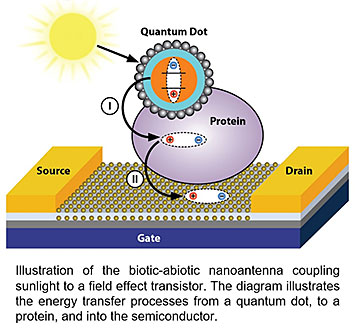Harvesting Light with Nature-inspired Nanoantennae
December 30, 2019
What is the scientific achievement?
Inspired by nature’s light harvesting architectures, CFN staff and users created a hybrid nanoantenna using quantum dots, a two-dimensional (2D) semiconductor, and a light harvesting protein from cyanobacteria. The nanoantenna converts light to energy through efficient directed energy transfer—the same mechanism as in organisms occurring in nature. Incorporating the nanoantenna into a photocurrent transistor improves light absorption by 5 times, compared to a device without the antenna.
Why does this achievement matter?
Organisms in nature harvest energy using antennae to direct sunlight to reaction centers and convert it to chemical energy. This work is a first demonstration using a biotic-abiotic antenna to direct energy transfer to an atomically thin, 2D semiconductor.
What are the details?
Inspired by nature’s light harvesting complex architectures, which bring together several active nanocomponents to harvest light and to flow the harvested energy in precise directions and places, a biotic/abiotic step-wise energy transfer nanohybrid based on an atomically thin, two-dimensional (2D) van Der Waals semiconductor, colloidal quantum dots and a light harvesting protein was designed. Through bandgap engineering of the self-assembled active components, efficient directional stepwise energy transfer, from optically excited quantum dots, to proteins and finally to the 2D van Der Waals semiconductor was achieved. The biotic/abiotic nanohybrid exhibited enhanced absorption cross section and enhanced light harvesting through the addition of quantum dots and proteins next to MoSe2, which in turn led to enhanced exciton generation in MoSe2 via energy transfer from quantum dots to proteins and finally to MoSe2.
CFN Capabilities:
The CFN Advanced Optical Microscopy Facility was used to perform optical and photoelectrical measurements.
Publication Reference
M. Li, J.-S. Chen, M. Cotlet, Efficient Light Harvesting Biotic–Abiotic Nanohybrid System Incorporating Atomically Thin van der Waals Transition Metal Dichalcogenides, ACS Photonics 6, 1451 (2019).
DOI: 10.1021/acsphotonics.9b00090
https://doi.org/10.1021/acsphotonics.9b00090
https://pubs.acs.org/doi/full/10.1021/acsphotonics.9b00090
https://www.sciencedaily.com/releases/2019/06/190612141324.htm
BNL Newsroom, Hybrid Nanostructure Steps Up Light-Harvesting Efficiency: https://www.bnl.gov/newsroom/news.php?a=115556
https://www.osti.gov/biblio/1558254
Acknowledgement of Support
This work was carried out at the Center for Functional Nanomaterials, Brookhaven National Laboratory (BNL), which is supported by the U.S. Department of Energy, O?ce of Basic Energy Sciences, under Contract No. DE-SC0012704. This material is based upon work supported by the U.S. Department of Energy, O?ce of Science, O?ce of Workforce Development for Teachers and Scientists, O?ce of Science Graduate Student Research (SCGSR) program. The SCGSR program is administered by the Oak Ridge Institute for Science and Education (ORISE) for the DOE. ORISE is managed by ORAU under contract number DE-SC0014664. All opinions expressed in this paper are the author’s and do not necessarily re?ect the policies and views of DOE, ORAU, or ORISE.
2019-17054 | INT/EXT | Newsroom










